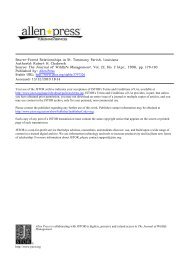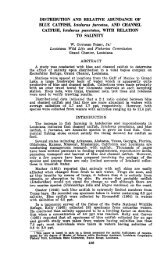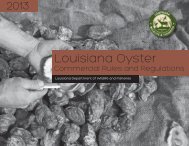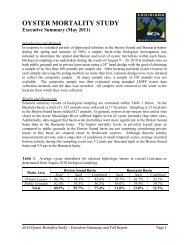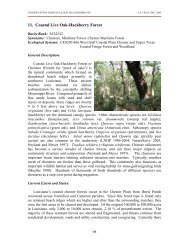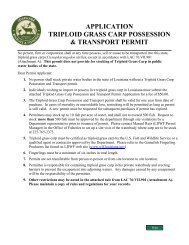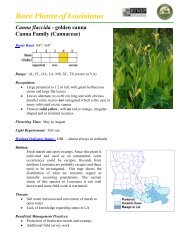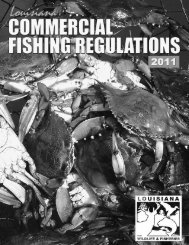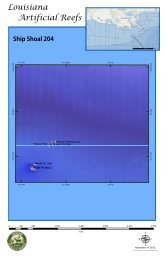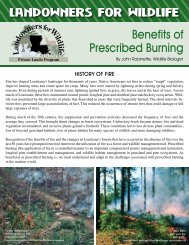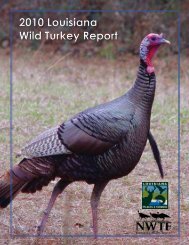Wildlife Insider Spring Summer 2010 - Louisiana Department of ...
Wildlife Insider Spring Summer 2010 - Louisiana Department of ...
Wildlife Insider Spring Summer 2010 - Louisiana Department of ...
You also want an ePaper? Increase the reach of your titles
YUMPU automatically turns print PDFs into web optimized ePapers that Google loves.
Figure 3. Mixed pine hardwood stands <strong>of</strong>ten <strong>of</strong>fer the most diverse array <strong>of</strong> deer browse species inthe understory.or even second, estrus cycle the next seasonif their body conditions do not improve.The resulting late born male fawns likelywill exhibit poorer antler development asyoung bucks due to the late and suppressedstart.To understand the long-term CC <strong>of</strong> atract <strong>of</strong> land or habitat type, an entire forestcycle must be considered. Even withinthe same soil region, a short-rotation pineplantation that is intensively managed forfast growing pulpwood or chip products,will have a different average annual deerCC than a more plant-diverse, long-rotationmixed pine/hardwood stand managedfor sawtimber. The forestry managementobjectives are different, and thus the forestmanagement regime is different.Recent research in pine plantations illustratesthe complexities <strong>of</strong> habitat quality.Mechanical, chemical and prescribed firetreatments and the timing <strong>of</strong> these managementtechniques have varying effects onplant composition and browse quantity andquality. Broadcast herbaceous weed controlreduces forage biomass significantly morethan banded herbaceous weed control (herbicidesapplied on a narrow strip along theplanted trees) (Jones et al. 2009). When anexotic woody plant, such as Chinese tallow(Triadica sebifera) or even a native likesweetgum (Liquidambar styraciflua), becomedominant in the under or mid-story,management action may be necessary toimprove wildlife habitat and forest regeneration.Selective herbicide and prescribedfire application can be used to increaseimportant deer forages in these situations(Mixon et al. 2009).The accompanying photos from thesame tract <strong>of</strong> land illustrate a variety <strong>of</strong> habitatconditions that are common to <strong>Louisiana</strong>.The department’s deer program is developinga joint research project with <strong>Louisiana</strong>State University that will provide furtherinsight into deer CC across several <strong>of</strong> thestate’s physiographic regions. Plants thatare important to deer will be measured andanalyzed for nutritional composition acrossthe state (Moreland 2005). This informationwill help biologists and deer managers betterunderstand habitat potential and assistthem in educating hunters about realisticexpectations concerning deer numbers.Literature citedFigure 4. This pine plantation has good browse availability, but unless complimented with mastbearing species along stream side management zones or adjoining tracts, it will not have the productivityor long -term carrying capacity desired by many hunters.deer, especially the second year, when thereis a complete mast failure. A pregnant femalewill go into the spring in poorer condition.If deer numbers are too high and thereis a summer drought, then browse and itsnutrient content will be even lower. Theremay be less milk for her fawns and morestress on the doe, perhaps making her a lesssuccessful mother. Her fawns will be smallerand have lower chances <strong>of</strong> survival. Ifshe were a normal 3.5-year-old doe on averageto good habitat, she should have tw<strong>of</strong>awns. But if she loses one <strong>of</strong> them, there isa 50 percent reduction in recruitment fromthis individual. If this happens across alarger sample <strong>of</strong> females, the results will bean overall reduction in recruitment and deeravailable for harvest in succeeding years.The same does may not breed on their first,<strong>Spring</strong>/<strong>Summer</strong> <strong>2010</strong>Jones, P.D., S.L. Edwards, and S. Demarais.2009. White-tailed deer foraging habitat inintensively established loblolly pine plantations.Journal <strong>of</strong> <strong>Wildlife</strong> Management73(4):488-496.Mixon, M.R., S. Demarais, P.D. Jones, andB.J. Rude. 2009. Deer forage response toherbicide and fire in mid-rotation pine plantations.Journal <strong>of</strong> <strong>Wildlife</strong> Management73(5):663-668.Moreland, D. 2005. Checklist <strong>of</strong> woody andherbaceous deer food plants <strong>of</strong> <strong>Louisiana</strong>.LDWF First ed. publication.9



